XFX R9 290 Double Dissipation:Review | Test | Specs | Price | CPU Performance| Hashrate| Setup| Config | Advantage (Pros) and Disadvantages (Cons) and other important features that will help you make better decision.
We continue with the tests of XFX products with today a graphics card but not least because it is a high-end model, the R9 290 Double Dissipation!
Hashrate: XFX R9 290 Double Dissipation
Equipped with the brand’s Double Dissipation cooling system which is now beginning to be known, this R9 290 uses AMD reference frequencies, performance should therefore be very good and noise pollution under control, at least I hope so! As usual here is a small summary of the different cards of the “R” series from AMD:
| Menu | GPU | Transistors (in billions) | ROPs | GPU Frequency / Memory | Memory Capacity | Bus |
|---|---|---|---|---|---|---|
| R9 295X | 2x Hawaii | 2 x 6.2 | 2 x 64 | 1018 / 1250 | 2 x 4 GB | 512 bits |
| R9 290X | Hawaii | 6.2 | 64 | 1000 / 1250 | 4 GB | 512 bits |
| R9 290 | Hawaii | 6.2 | 64 | 947 / 1250 | 4 GB | 512 bits |
| R9 280X | Tahiti | 4.3 | 32 | 1000 / 1500 | 3 GB | 384 bits |
| R9 280 | Tahiti | 4.3 | 32 | 933 / 1500 | 3 GB | 384 bits |
| R9 270X | Pitcairn | 2.8 | 32 | 1050 / 1400 | 2 or 4GB | 256 bits |
| R9 270 | Pitcairn | 2.8 | 32 | 925 / 1400 | 2 GB | 256 bits |
| R7 265 | Pitcairn | 2.8 | 32 | 925 / 1625 | 1 or 2 GB | 128 bits |
| R7 260X | Bonaire | 2.08 | 16 | 1100 / 1625 | 2 GB | 128 bits |
| R7 260 | Bonaire | 2.08 | 16 | 1000 / 1500 | 1 GB | 128 bits |
| R7 250 | Holland | 1.04 | 16 | 1050 / 1150 | 1 GB | 128 bits |
| R7 240 | Holland | 1.04 | 16 | 780 / 1150 | 1 GB | 128 bits |
With 947Mhz for the GPU and 1250Mhz for the memory, the card from XFX is identical to these specifications.
Characteristics

Specification: XFX R9 290 Double Dissipation
| XFX R9 290 Double Dissipation | |
|---|---|
| GPU | Hawaii Pro |
| GPU frequency | 947MHz |
| Memory Frequency | 1250 Mhz |
| Amount of memory | 4 Go de DDR5 |
| Memory bus | 512 bit |
| Connectivity | 2 x DVI-D 1 x HDMI 1 x mini Display Port |
| Dimensions | 29.5 x 14.3 x 4.2 cm |
| Food | 1 x 6-pin 1 x 8-pin |
| Price | ~ 370€ |
| Guarantee | 2 years |
As I just said the characteristics are identical to the reference card, 947Mhz for the GPU, 1250Mhz for the memory, 4GB of DDR5 on 512-bit bus etc. The connection is also very classic with 2 DVI-D ports , 1 HDMI port and a mini Display Port. The dimensions of the card are on the other hand rather generous with its 29.5 cm long, 14.3 cm high and 4.2 cm thick, it will be necessary to pay a minimum attention to the place in the case before make the acquisition!
Box and Bundle
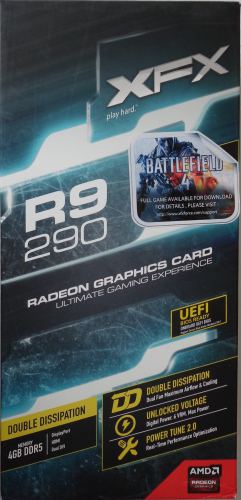
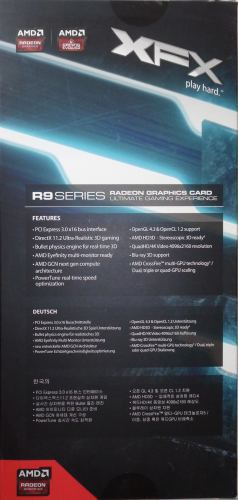
The box is in all respects identical to all the other cards of the brand, the model as well as a small listing of the main features such as unlocked voltages, Powertune 2.0 and the presence of the Double Dissipation cooling system. A small sticker is present stating that Battlefield 4 is offered with this card, which is a little more significant.
At the back a more complete listing of the features is present (PCIe 3.0, Directx 11.2, AMD Eyefinity etc ..), oddly there is no excessive marketing and only a small “Ultimate Gaming Experience” reminds us of this. ‘order!

As usual under the cover there is a cardboard box all the more classic, with the XFX logo inlaid!
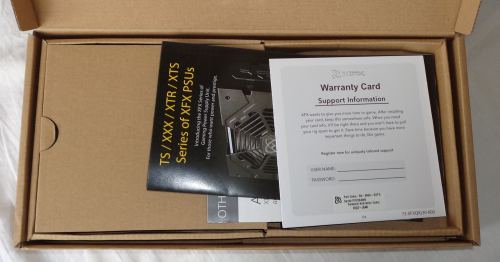
When opening, we find a first compartment containing the driver CD, a few small sheets and the rest of the bundle.
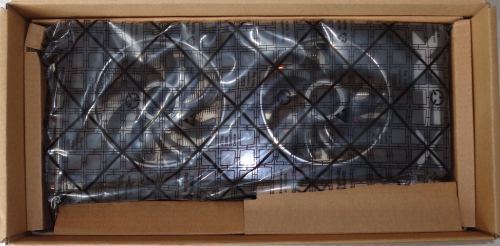
Once the first compartment has been removed we come face to face with the beast in its plastic bag and surrounded by cardboard, although everything seems solid, a little foam might have been more reassuring, but it is only a small unimportant detail!

The bundle consists of:
- The various warranty and quick installation sheets
- 1 CD de drivers
- 1 adapter 2 x Molex 4-pin -> 1 x PCIe 6-pin
- 1 adaptateur 2 x PCIe 6-pin -> 1 x PCIe 8-pin
The bundle therefore offers the minimum vital to connect the graphics card, adapters are a little extra in case the power supply does not have all the required connectors.
The map
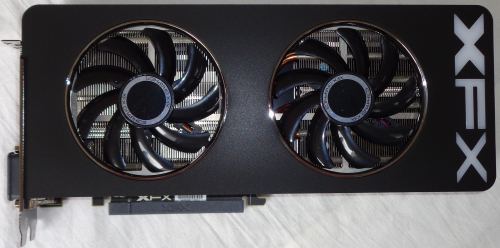
Here is the beast! Rather classy and sober XFX has not been extravagant here, and we’re not going to complain! All dressed in black, whether the matte black fairing or the glossy black fans, the XFX also gives an impression of quality and solidity. An XFX logo is present on the right which lights up when the card is powered on, watch out for your eyes!
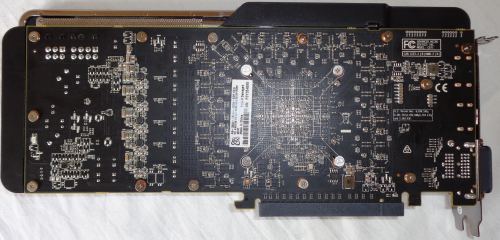
At the back we can see that the card is fixed everywhere to heatsinks / front fairing, the rigidity of the card is thus improved, which is not a bad thing when seeing the dimensions of the machine. No back plate though here, too bad 🙂


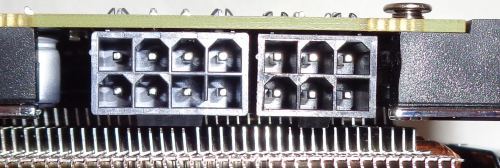
De profil on découvre 2 carénages en plastique noir entourés d’un liseré couleur argent du plus bel effet, la carte profite d’un design soigné!
L’alimentation de la carte se fait par 1 connecteur PCIe 6-pin et 1 PCIe 8-pin, de quoi alimenter la carte comme il se doit même en cas d’overclocking poussé.
On déshabille la carte
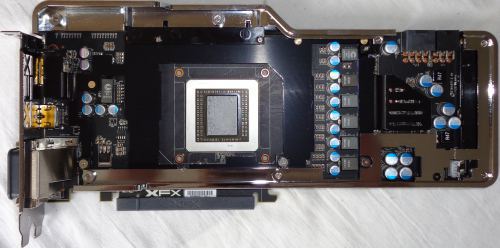
Une fois le système Double Dissipation enlevé on découvre une plaque de refroidissement noire chargée de tenir au frais la mémoire ainsi que les différents composants de l’alimentation, toutes les cartes ne disposent pas de ce type de plaque de refroidissement qui aide grandement à l’overclocking.
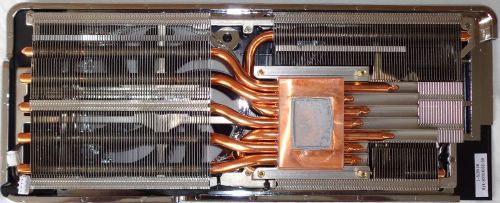
Here is the brand’s Double Dissipation cooling system seen from below, there are no less than 7 callpipes which is huge (as a reminder 5 on the HIS R9 290 and the Sapphire 7950 Dual-X) and should ensure very good cooling of the graphics processor.
Powertune
With the evolution of Powertune there was a need for a little explanation of why and how, what is Powertune? AMD introduced a control unit integrated into the GPU which allows to limit some things:
- The consumption of the card cannot exceed 208 Watts with the original settings.
- GPU temperature cannot exceed 95 °
In practice this means that regardless of your overclocking or the conditions of use of the card (very well ventilated case or not) the GPU will not exceed 208Watts and will not exceed 95 °, to do this Powertune comes into play and will automatically reduce GPU frequency to meet one or both of these limitations.
Of course it is possible to override these directives by modifying the settings in Catalyst or any other overclocking software (such as iPower from HIS) of the “Board Power Limit”, by increasing to a maximum of 50% the GPU alone is allowed to consume up to 300 Watts even if the maximum temperature is still 94 °, here is a screenshot of the AMD CCC:
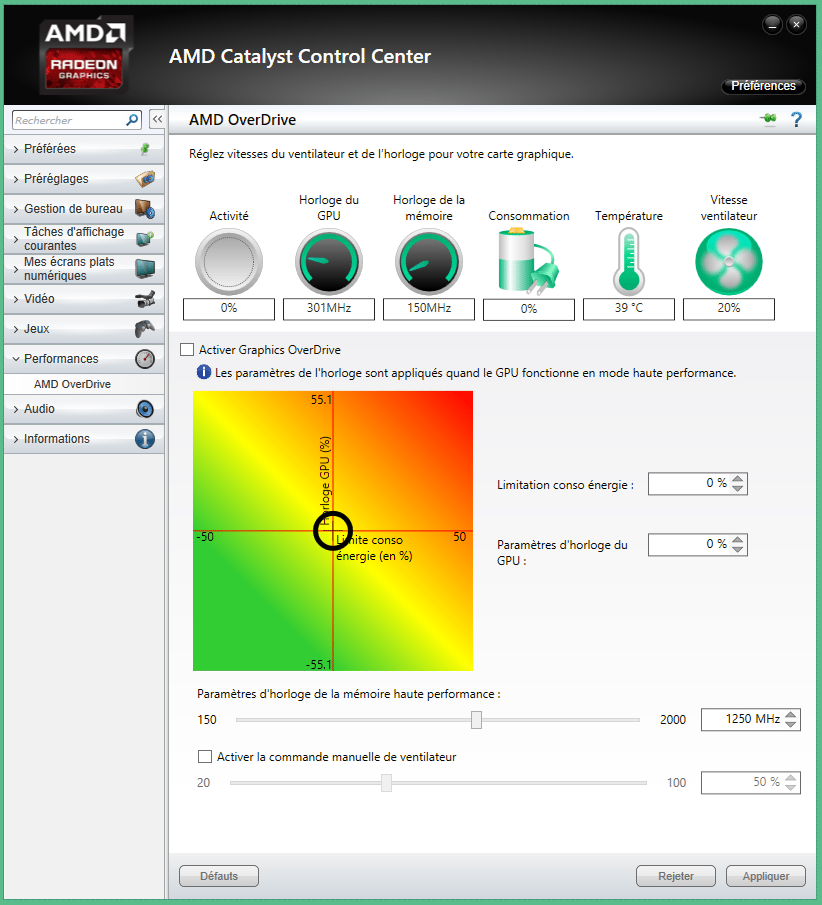
So yes it’s good to be able to adjust the energy consumption limitation but by setting + 50% you have to realize that the card will heat up enormously and therefore reach the 95 ° level very quickly in the event of overclocking with air cooling I would show you in the overclocking section how the GPU frequency suffers.
The test platform
The configuration used during the tests is as follows:
- Processor : Intel Core i4670K @ 4 Ghz
- Motherboard : Gigabyte Z87-UD5H TH
- Mémoire: Kingston HyperX 4 x 2 Go 1600Mhz
- Disque dur: WD Raptor 150 Go
- Power supply : Seasonic X650
- Drivers: Catalyst 14.4 (AMD) & GeForce 337.88 (nVidia)
- Operating system : Windows 8.1 64bits
All games will be tested in 1920 × 1080 detail in full detail (except the TressFX on Tomb Raider), which is the current ‘standard’, the graphics cards used in testing are as follows:
- XFX R9 290 Double Dissipation
- XFX R9 285 Black Edition (tested here)
- MSI R9 290 Gaming OC 4GB (tested here)
- HIS R9 290 iPower IceQ X² OC 4GB (testée ici)
- XFX R9 280 Double Dissipation (tested here)
- Sapphire 7950 Dualx @ 900Mhz
- Sapphire 7970 Ghz Edition
- MSI R9 280X Gaming (tested here)
- Asus GTX770 DirectCU OC
Consumption / Temperature

The consumption test was carried out under OCCT Power Supply which makes it possible to push the consumption of the components to the maximum, note that this value reflects the Total consumption at the outlet of the machine and not the graphics card itself!
The consumption of the XFX R9 290 Double Dissipation is in the average of the R9 290, with 10Watts more than the HIS but this is certainly due to the 10 Watts more which are modified in the bios at the level of consumption (208 Watts for the HIS and 218 Watts for the XFX).

The temperature of the GPU of the XFX R9 290 is quite good and is in the average of R9 290 once again, on the other hand the VRMs heat up a lot (100 ° for VRM1), we will see this later when overclocking 🙂
Powertune
As explained above, Powertune is responsible for keeping the GPU consumption at a maximum of 208Watts and / or a maximum temperature of 95 °, let’s see the impact that this has on the operating frequencies of the card in 2 different tests:
- OCCT Power Supply factory settings
- OCCT Power Supply by increasing the consumption limitation by 50%
With these 4 tests we will see how the increase in the consumption limit “unleashes” the performance of the card as well as the impact that this has during the OCCT test, which is particularly demanding for graphics cards.
OCCT Factory :

Powertune very rarely activates at the original frequencies under OCCT, only a few slight spikes are to be noted but nothing too bad.
OCCT Factory + 50% consumption limit :

With the consumption limitation increased by 50%, the card remains stable at the original frequencies, which is quite normal.
Sound level
Warning: Part to be taken with a grain of salt, unfortunately not having access to the appropriate equipment and using an android application to take the readings The measurements below are only indicative! The readings were taken 20cm from the graphics card.
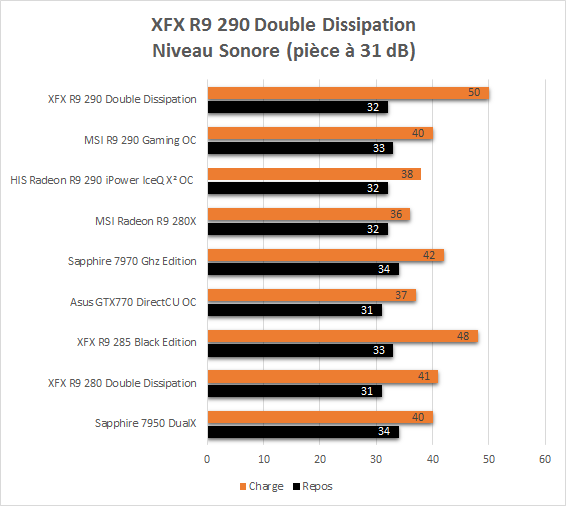
Ouch, the XFX R9 290 DD at rest is very quiet but on the other hand under OCCT the fans get excited a lot and with 50 dB it is the noisiest card in the comparison. Results to be put into perspective however because under OCCT the sound level is not representative of what this can give during a game but rather a maximum value. On the other hand, given the temperatures of the GPU, the ventilation profile could have been less aggressive, the reason for such behavior lies in the temperature of the VRMs which rises very quickly (100 ° at the original frequencies, I remind you) and therefore aggressive ventilation is needed, too bad!
3DMark Fire Strike
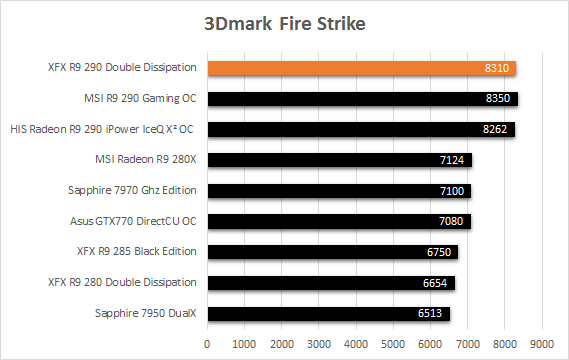
The XFX R9 290 is at the level of the other R9 290s, which is my faith completely normal, and we will see that this will be verified throughout the tests!
Battlefield 4
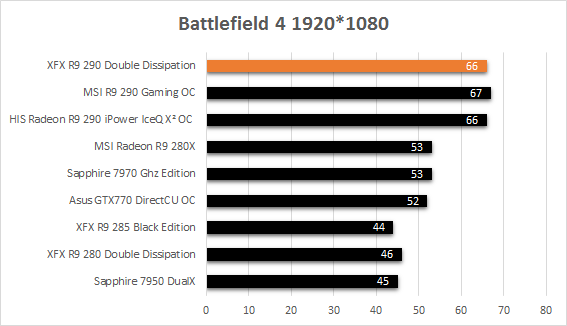
Bioshock Infinite
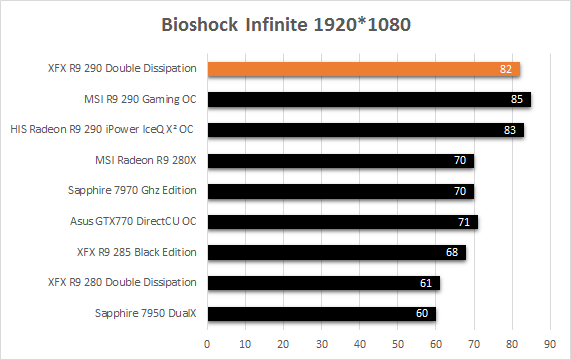
Crysis 3
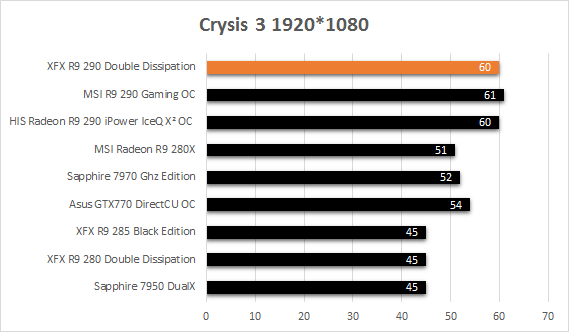
Hitman Absolution
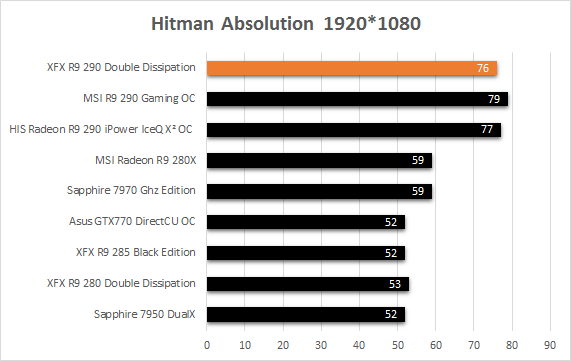
Tomb Raider
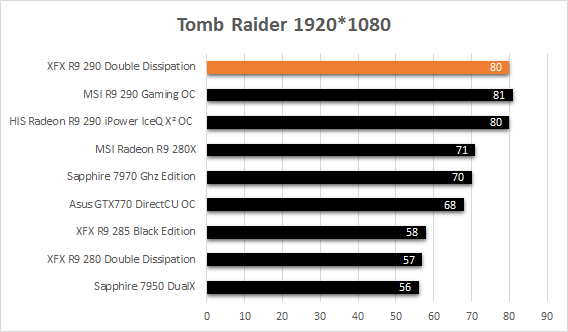
Summary of performance
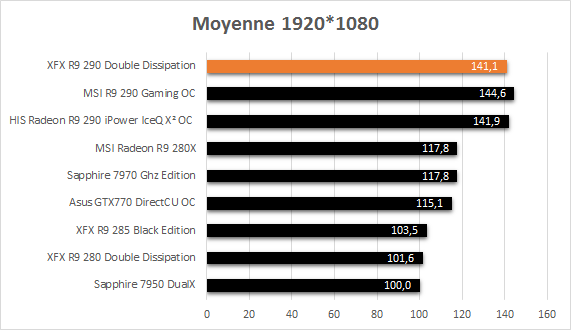
As we could see the results are almost equal to all the other R9 290s in the comparison, the MSI is a bit faster but this is only due to its factory overclocking, the XFX R9 290 Double Dissipation would have the same results at equal frequency. The R9 280X and 285 are far behind, the R9 290 is definitely very efficient.

The maximum overclocking achieved is:
- GPU: 1080 Mhz (+133 Mhz)
- Memory : 1500 Mhz (+ 250 Mhz)
Note that given the temperatures of the VRMs when overclocking to the original voltage I stopped there, an increase in voltage would most certainly have exceeded the maximum temperature of these small chips (130 °).
Consumption
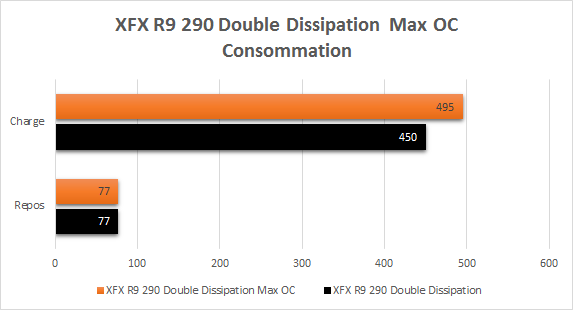
The consumption of the machine goes from 440 Watts to 495 Watts, which is still a significant increase, without being excessive. Note once again that this represents the maximum consumption of the entire configuration under OCCT, in game it will be considerably less.
Temperature
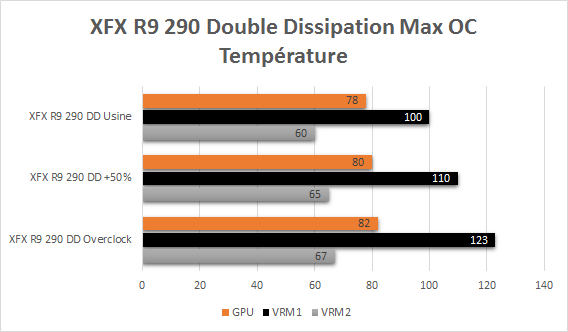
Well here we are right in the subject that annoys this XFX R9 290, the temperature! The GPU is very well cooled with a maximum of 82 ° during overclocking, nothing to say at this level, on the other hand with regard to VRM1 the figures reach new heights! With 123 ° without changing the GPU voltage, it’s very hot, too hot to really guarantee the long-term survival of the card if it is used for mining for example, in the game there will logically be no of problems but you will have to be very careful.
Powertune
OCCT GPU: 1080 MHz MEM: 1500 MHz:

Powertune is no spoiler when overclocking and the GPU maintains its 1080MHz with no worries.
Sound level
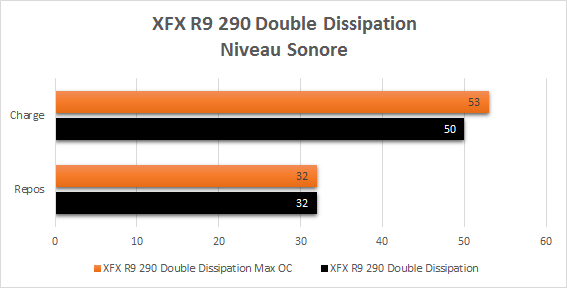
We still take 3dB for overclocking to reach 53dB, which is still rather noisy, the fault of these poorly cooled VRMs.
Let’s see the gain obtained thanks to this little overclocking! Anyway with the R9 290 if you really want to overclock the card and keep your ears to a minimum, you will have to go through a more advanced cooling system, of the Prolimatech MK-26 style in aircooling or a watercooling system.
Results
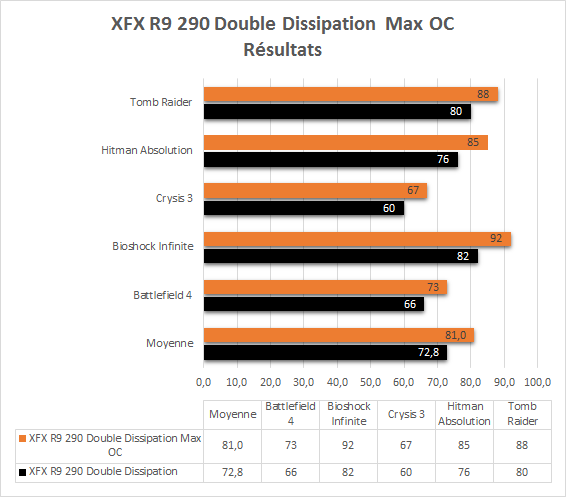
With the maximum overclocking of the XFX R9 290, the gain is not negligible in games with an average of 11% more performance, which is no small feat!
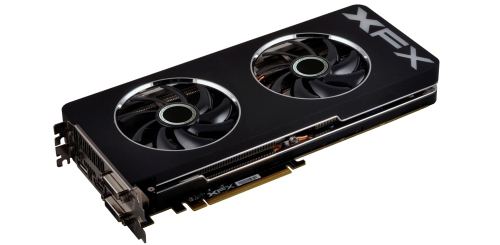
Here we are at the end of this test, what about the XFX R9 290 Double Dissipation?
The performances are of course very good, AMD R9 290 obliges! The build quality is also at the rendezvous as usual expensive XFX.
On the other hand, the noise pollution is not really up to what I saw for example on the model R9 280 Double Dissipation which is however equipped with the same cooling system, the fault of the VRMs which are really not enough well cooled and therefore cause too much fan acceleration. The radiators present on the VRMs are clearly undersized with 123 ° when overclocking without increasing the voltage, which is too excessive even if the temperature has been recorded under OCCT.
On the other hand, the good news is on the price level, the card will soon be available at 289.95 € which is very good, the XFX R9 290 is not perfect but will be very good in a gamer configuration as long as the overclocking. is not pushed too hard.
Advantages
- Performances
- Build quality
- Design
- Price
Disadvantages
- Noise under load
- VRMs temperature
A big thank you to Jérémie from Goldenfish who allowed me to do this test.















